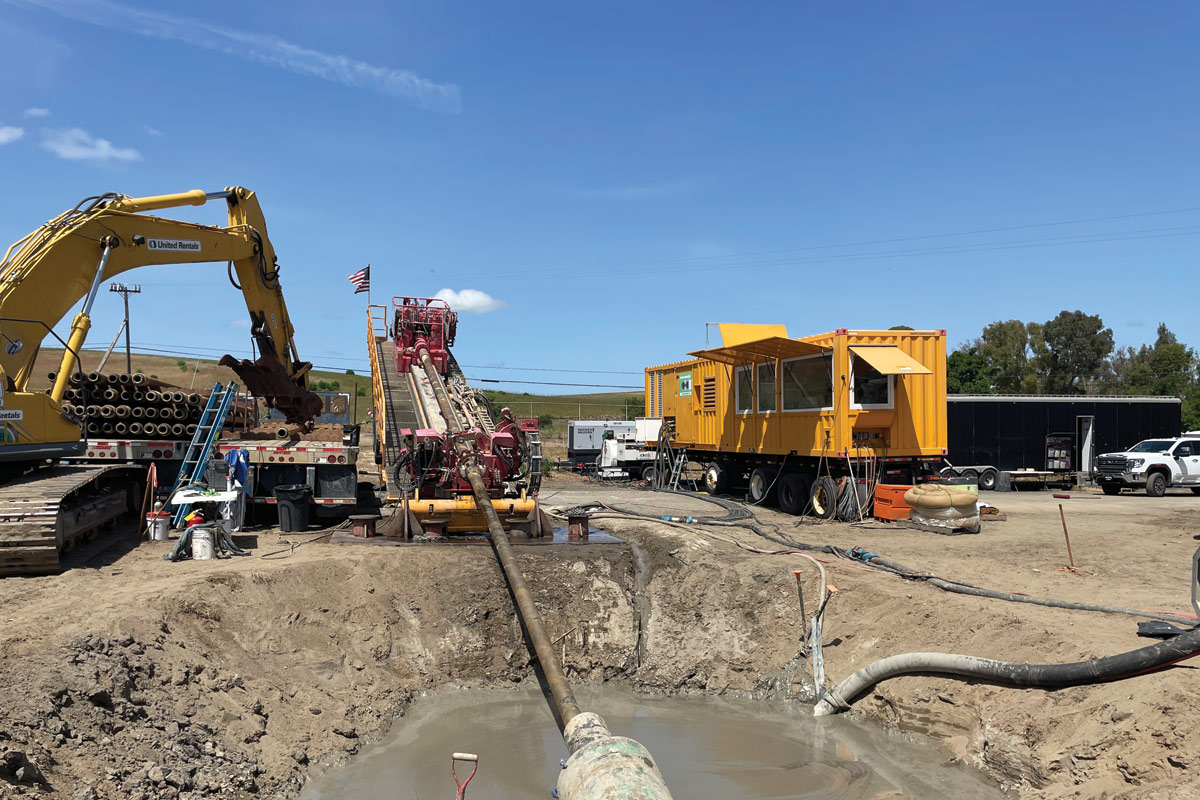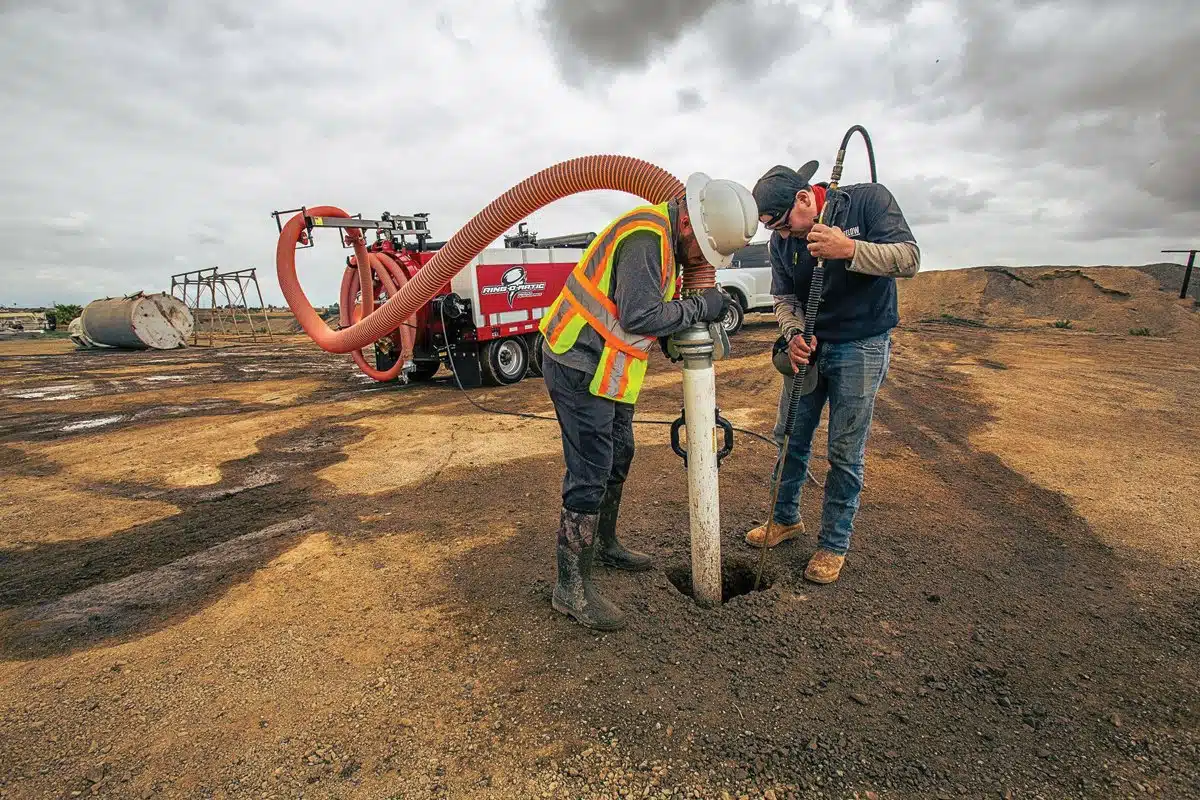Vacuum Excavation and HDD: A Quick Overview
February 18, 2014
 Vacuum excavators have become a common site on horizontal directional drilling (HDD) jobs these days.
Vacuum excavators have become a common site on horizontal directional drilling (HDD) jobs these days. A vacuum excavator is two machines in one compact package: a vacuum excavator using “soft” excavation technology to make precisely controlled excavations, and a powerful vacuum for multipurpose clean-up tasks.
Both of these capabilities often are essential on many HDD projects.
Most vacuum excavators on directional drilling projects are compact trailer-mounted models that also can be mounted on the flat bed of a truck. There are also dedicated truck mounted vacs available. HDD crews make good use of both functions: excavation to dig potholes to visibly identify the exact location of existing utilities, and the vacuum function to clean up drilling fluids escaping from the bore hole during drilling, backreaming and pullback.
A vacuum excavator employs one of two methods for excavation. Either high-pressure water or high-pressure air can be used. Some units use water which penetrates and displaces soil. In the vacuum mode, the machine sucks up drilling fluid or most any other type of debris, then deposits it into a holding tank for later disposal.
Vacuum excavation is not a new technology–the first truck-mounted models were developed in the 1950s by a company for its own use for “keyholing.” This is a process used to create small holes to make repairs to underground gas pipes.
One of Ditch Witch’s first experiences with the technology was in the mid-1990s. A customer, Enterprise Trenchless Technologies Inc. had a high-profile project to install a gas service to the Bunker Hill Monument and Museum. A small drill unit was set up at the top of the hill to drill down to the street where the new pipe would be connected to the gas main.
Soon, drilling fluid began coming out of the pilot hole, and thick, brown slurry rolled down the carefully manicured hillside. The park service representative on site stopped the drilling immediately. He said the fluid’s presence on the site was unacceptable.
One of the Ditch Witch dealerships happened to have a small vacuum excavator in stock. A call was made and in a few minutes, a pickup arrived pulling the trailer-mounted machine which was set up near the drill. The vacuum hose sucked up the fluid as it emerged from the hole.
The gas line installation was quickly completed, and today vacuum excavators are at work every day doing exactly the same thing.
Potholing
Potholing to uncover utilities has been done for years, because the best way to be absolutely sure where a buried pipe or cable is located, is to uncover it and see it. For years, potholing was done with backhoes, small excavators, or by hand with shovels. However, any mechanical method of excavation risks damaging the utilities being uncovered which can cause further damage during construction.
Vacuum excavation provides a better alternative.
It is not an exaggeration to say vacuum excavators have revolutionized the potholing process. Depending on soil conditions, a compact vacuum excavator using soft excavation can dig a 12-in.-square, 5-ft deep pothole in less than 30 minutes At the same time it removes and contains spoils. Most important, by following proper procedures for operation of vacuum excavation equipment, utilities can be exposed without damage.
Not only is potholing the smart thing to do, many utility providers and general contractors require it. In fact some state regulations mandate it.
In many areas today, state regulators have established tolerance zones on each side of buried facilities — 18 to 36 in. on either side of a marked utility. Only hand digging or soft excavation, such as a vacuum excavator, can be used inside a tolerance zone.
In addition, any time a directional drill path crosses a buried utility the utility must be exposed to help avoid damage. The Common Ground Alliance (CGA) is a member-driven association dedicated to identifying and promoting effective practices to prevent damage to buried facilities. CGA’s Best Practice guidelines identify soft excavation as the best and preferred method of potholing.
While potholing often is mandated on directional drilling projects, many drilling contractors take responsibility for potholing in situations where the location of a buried line is uncertain. It takes a little time to do and is worth it if a costly and dangerous utility strike is avoided.
 Good for Other Excavation
Good for Other ExcavationThe vacuum excavator’s digging capabilities aren’t limited to potholing.
Typical utility applications include making short excavations to install cable and pipe. A crew member can easily take the machine’s water or air hose into small areas where other equipment can’t fit. They often are used to make pole holes and dig trenches in easements crowded with utilities. And they still are used for keyholing, the reason the first vacuum excavator was developed.
We’ve actually seen an increase in vacuum excavators for trenching, and it no longer is limited to short trenches. Sometimes several hundred feet is trenched in conditions where conventional excavation poses risks to existing utilities.
Drilling Fluid Clean Up
The use of drilling fluids is a critical element in directional drilling installations for completing the pilot bore, enlarging the hole, and product pullback. Otherwise, during these processes fluid will escape the borehole and flow onto the surface of the jobsite.
Even though most fluids do not pose hazards to the environment, most project owners expect work sites to be kept free of drilling fluids for appearance, environmental, and safety considerations. The Bunker Hill project previously cited is a good example; the project owner would not allow muddy fluids to detract from the well maintained park’s landscaping.
In most instances, compact vacuum excavators are the best method for this cleanup task. Other utility-related tasks include cleaning out meter and valve boxes, storm drains, lift stations, treatment plant laterals, vacuuming cuttings made by pavement saws and breakers, and most any type of general cleanup. Trailer and truck-mounted units are easily moved when needed. When not being used for clean-up, they are available for potholing or making other excavations.
When evaluating the selection of vacuum excavators on the market, physical size and the choice between water and air are primary considerations. Of course, there are many other specifications and features to consider.
 Productivity is related to a combination of factors. These include horsepower and torque curve of the power unit, type of positive displacement pump or blower used to create vacuum, capacity of pump or blower stated in cfm, speed of air flow through the system, filtering of air flow, pressure and gpm of water pump in the reduction phase, nozzle configuration of the excavation tool, and amount of water and speed of air at the reduction head.
Productivity is related to a combination of factors. These include horsepower and torque curve of the power unit, type of positive displacement pump or blower used to create vacuum, capacity of pump or blower stated in cfm, speed of air flow through the system, filtering of air flow, pressure and gpm of water pump in the reduction phase, nozzle configuration of the excavation tool, and amount of water and speed of air at the reduction head. Some other considerations are size and weight, capacity of the vacuum holding tank, weight of the unit when holding tank is full, capacity of water supply tank on water models, dust filtering systems on air units, and sound levels during operation.
Jason Proctor is a Ditch Witch product manager-vacuum systems, based in Perry, Okla.





Comments are closed here.